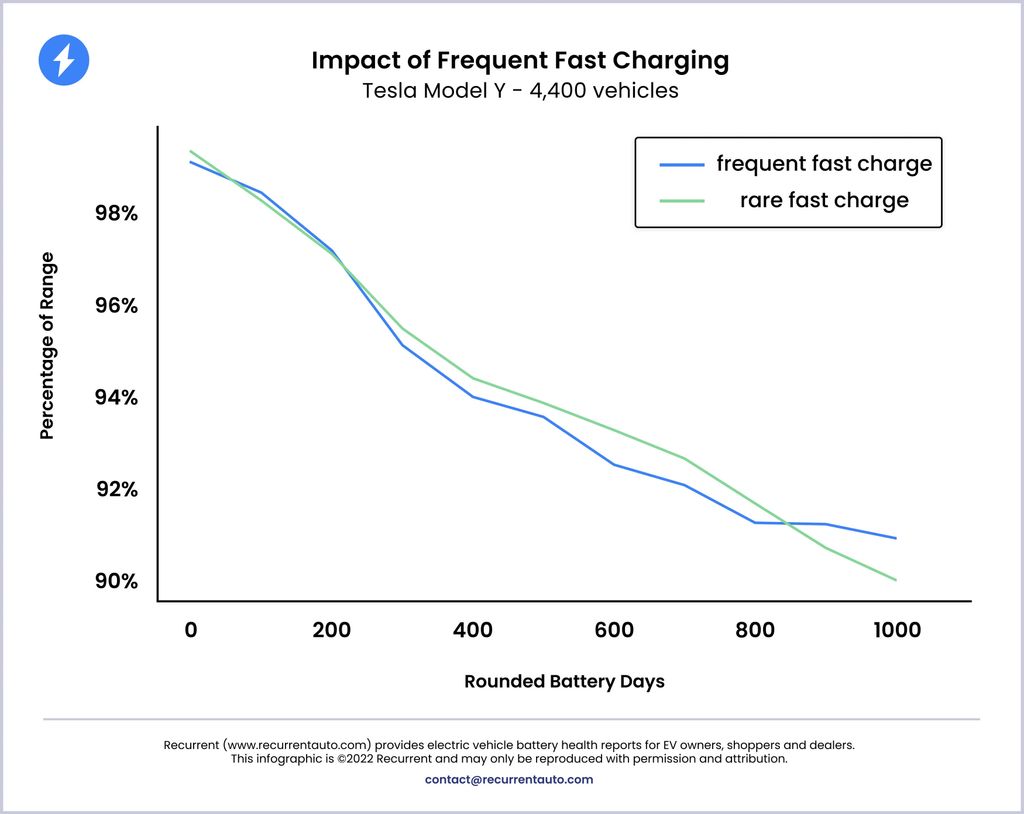Is constantly taking your electric car to a DC fast-charging station harmful to its battery pack? The short answer here is “no,” but we have to explain some things first.
How DC Fast Charging Works
Public “Level 3” DC fast-charging stations can bring an EV’s battery up to 80 percent of its capacity in around 15-45 minutes, depending on the vehicle and the outside temperature (a cold battery charges slower than does a warm one). While most electric car charging is done at home, DC fast charging can come in handy should an EV owner find the state of charge indicator getting nervously low while en route. Locating Level 3 stations is essential for those taking extended road trips.
DC fast charging uses multiple connector configurations. Most of the early models coming from Asian automakers used what’s called a CHAdeMO connector (Nissan Leaf, Kia Soul EV), while German, American and newer Asian EVs predominantly use the SAE CCS Combo plug, with many Level 3 charging stations initially supporting both types but now heavily favoring CCS. Tesla uses a proprietary connector (now called the North American Charging Standard or NACS) to access its high-speed Supercharger network, which is limited to its own vehicles. Tesla owners can, however, use other public chargers via an adaptor that comes with the vehicle.
Whereas home chargers utilize AC current that’s converted to DC power by the vehicle, a Level 3 charger feeds straight DC energy. That allows it to charge the car at a more rapid clip. A fast-charging station is in constant communication with the EV to which it’s connected. It monitors the car’s state of charge and delivers only as much power as the vehicle can handle, which varies from one model to another. The station regulates the flow of electricity accordingly so as not to overwhelm the vehicle’s charging system and damage the battery.
Once charging is initiated and the car’s battery is warmed up, the flow of kilowatts typically increases to the vehicle’s maximum input. The charger will sustain this rate for as long as possible, though it may drop to a more moderate speed if the vehicle tells the charger to slow down so as not to compromise battery life. Once an EV’s battery reaches a certain level of its capacity, usually 80 percent, charging essentially slows to what would then become Level 2 operation. This is known as the DC fast charging curve.
Effects Of Frequent Fast Charging
An electric car’s ability to accept higher charge currents is affected by the battery chemistry. The accepted wisdom in the industry is that faster charging will increase the rate at which an EV’s battery capacity will decline. However, a study conducted by the Idaho National Laboratory (INL) concluded that while an electric car’s battery will deteriorate faster if it’s only power source is Level 3 charging (which is almost never the case) the difference isn’t particularly pronounced.
Early Testing On Air-Cooled Nissan Leafs
The INL tested two pairs of Nissan Leaf EVs from the 2012 model year that were driven and charged twice daily. Two were replenished from 240-volt “Level 2” chargers like those used in one’s garage, with the other two taken to Level 3 stations. They were each driven on public roads in the Phoenix, Arizona area over the course of a year. They were tested under the same conditions, with their climate control systems set at 72 degrees and the same set of drivers piloting all four cars. The vehicles’ battery capacity was tested at 10,000-mile intervals.
After all four test cars had been driven for 50,000 miles, the Level 2 cars had lost around 23 percent of their original battery capacity, while the Level 3 cars were down by around 27 percent. The 2012 Leaf had an average range of 73 miles, which means these numbers represent a difference of around just three miles on a charge.
It should be noted that much of the INL’s testing over the 12-month period was conducted in extremely hot Phoenix weather, which can inherently take its own toll on battery life, as would the deep charging and discharging necessary to keep the relatively short-range 2012 Leaf running. These temps can be extremely harsh on air-cooled EV batteries like those found in the Leaf.
Newer Testing Shows Fast Charging Has Even Less Of An Impact
How much will the battery degrade over time if fast charging is used predominantly? Recurrent set out to answer this question in a recent test involving some Teslas. The chart below captures the results.
The study analyzed charging data from over 12,500 Tesla vehicles in the United States, the rate of range degradation for cars that frequently fast charge is statistically similar when compared to AC charging.
The company, which provides vehicle and battery analysis reports for EVs, compared cars that fast charge at least 90 percent of the time to cars that fast charge less than 10 percent of the time. The results show little to no difference between the two charging methods.
This means that newer electric cars are even less likely to have significant battery degradation when fast charged often than the early electric cars like the Nissan Leaf.
The overall takeaway here is that while DC charging may have an effect on an electric car’s battery life, it should be minimal, especially since it’s not typically a primary charging source.
Or, in simpler terms, fast charge your EV as needed. You don’t have to worry about any significant difference in battery life.


